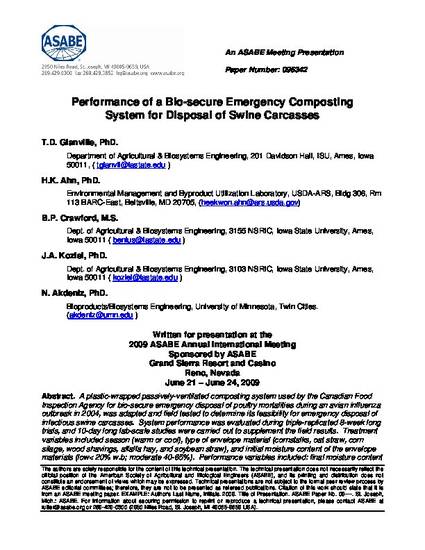
A plastic-wrapped passively-ventilated composting system used by the Canadian Food Inspection Agency for bio-secure emergency disposal of poultry mortalities during an avian influenza outbreak in 2004, was adapted and field tested to determine its feasibility for emergency disposal of infectious swine carcasses. System performance was evaluated during triple-replicated 8-week long trials, and 10-day long lab-scale studies were carried out to supplement the field results. Treatment variables included season (warm or cool), type of envelope material (cornstalks, oat straw, corn silage, wood shavings, alfalfa hay, and soybean straw), and initial moisture content of the envelope materials (low< 20% w.b; moderate 40-65%). Performance variables included: final moisture content and leachate production; ability to sustain desirable internal O2 concentrations; % carcass (soft tissue) decomposition; and ability to attain and sustain pathogen-killing temperatures. Despite release of significant amounts of water from carcasses, and being wrapped in plastic sheeting, little leachate accumulation was observed and the moisture content of envelope materials was generally lower at the end of the trail than at the beginning. All materials, except corn silage, were able to maintain internal O2 concentrations of 10% or higher when air was supplied through flexible 10 cm diameter ducts spaced at 2m intervals. O2 concentrations in corn silage often dropped below 10% even though aeration ducts were spaced at 0.5m intervals. Corn silage demonstrated superior pathogen killing potential. Average daily temperatures in the carcass layer of silage test units during the first 30 days of composting (T30) exceeded 50 oC, and USEPA Class B criteria for pathogen reduction were achieved at 90% of monitored locations. T30 values for cornstalks, soybean straw, and alfalfa hay are about 40 oC, and Class B criteria were achieved in only 45-57% of monitored locations in the carcass layer. Wood shavings and oat straw had the worst temperature performance with T30 values of only about 30 oC, and a Class B success rate of about 35%. Mean soft tissue decomposition in the field was lowest in corn silage (72%), and highest in cornstalks and soybean straw (87% and 85% respectively).
Available at: http://works.bepress.com/thomas_glanville/28/

This is an ASABE Meeting Presentation, Paper No. 096342.